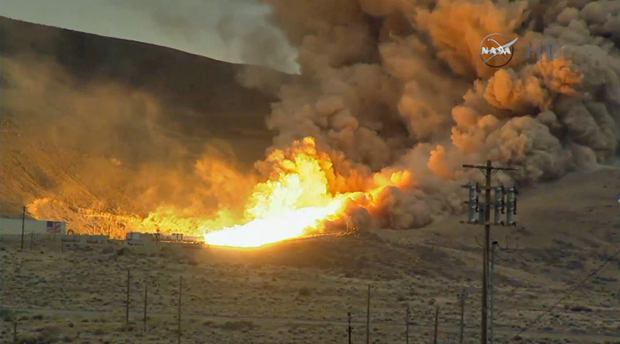Mega rocket booster put through fiery test
Locked down in a massive test stand, an upgraded five-segment solid-fuel booster thundered to life in Utah Wednesday in a spectacular test firing, generating 3.6 million pounds of thrust during a two-minute "burn" that generated a 5,000-degree torrent of flame and a towering plume of exhaust visible for miles around.
The shuttle-heritage booster, intended to help push NASA's planned Space Launch System super rocket out of the dense lower atmosphere, ignited with jarring rush of fire at 11:30 a.m. EDT (GMT-4), shattering the early morning calm at Orbital ATK's Promontory, Utah, manufacturing facility.
Cheered on by Orbital ATK employees and NASA officials watching from a viewing area a safe distance away, the 177-foot-long 1.6-million-pound booster fired for a bit longer than two minutes as planned before exhausting its load of solid propellant. As the propellant burned away inside the rocket, television cameras showed nearby vegetation and rocks steaming in the radiated heat as a towering column of exhaust climbed into the sky.
As the last of the propellant was consumed, a swing arm rotated into the smoking nozzle, injecting 31 tons of carbon dioxide into the body of the booster to quench any lingering flame and "to preserve the state it was in during the test," said a NASA spokeswoman. "This allows the team to get the best data on how it will perform during flight."
In addition, nozzles facing the lower side of the booster began spraying 2,300 gallons of water per minute on the rocket's casing to lower temperatures from around 1,000 degrees Fahrenheit to just 300 degrees, preventing any heat-related damage to the structure.
Space shuttles relied on two four-segment boosters to get of the launch pad while the huge SLS rocket will use two upgraded five-segment SRBs, each one generating 3.6 million pounds of thrust. The SLS first stage also will use four leftover space shuttle main engines burning liquid oxygen and hydrogen propellants.
The test firing Wednesday marked the fourth ground test of the new five-segment booster and the first qualification motor, or QM, firing, testing the rocket's hydraulic steering system, fuel mixture, insulation performance and a redesigned nozzle. Some 531 channels of telemetry were recorded from hundreds of sensors.
The booster was heated to 90 degrees before ignition to simulate launch in warm weather. A second test firing in 2016 will test the motor under cold-weather conditions. Todd May, NASA's SLS program manager, said the QM-1 test firing was a "really big deal for us."
"These motors have 25 percent more energy than the motors we used to get the shuttle off the ground," he said. "QM-1 is the first of two tests that will used to qualify the motors for flight. We're actually already building the pieces of the second qualification motor. This is a really exciting time for all of us."
Engineers will tear the QM-1 booster apart to inspect its internal components and carry out an exhaustive review of data collected during the test firing to make sure the booster performed as expected.
In the meantime, "it looked really clean, we're very excited," said Charles Precourt, a former space shuttle commander who now serves as Orbital ATK's vice president and general manager for propulsion systems.
"It's a great result," he said. "You could feel the pressure coming off the motor, you could see the plume and watch the (nozzle steering system) vectoring. It all looked great. We'll be looking for the quick-look data, but a really nice result."

